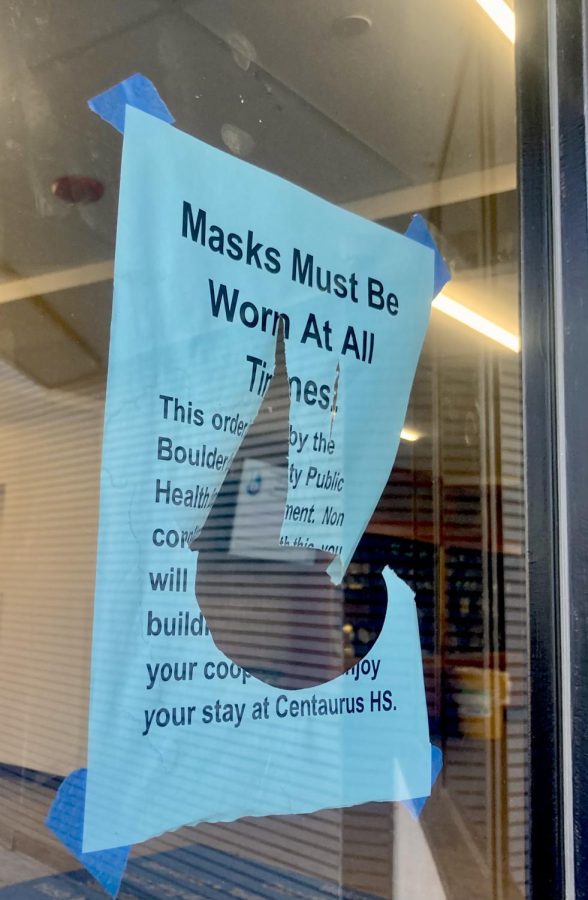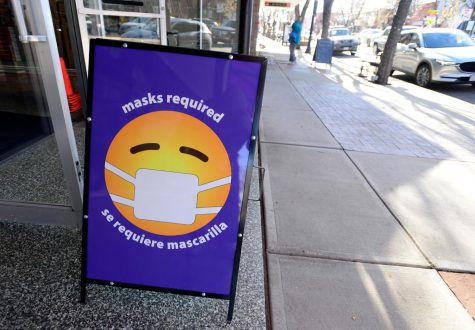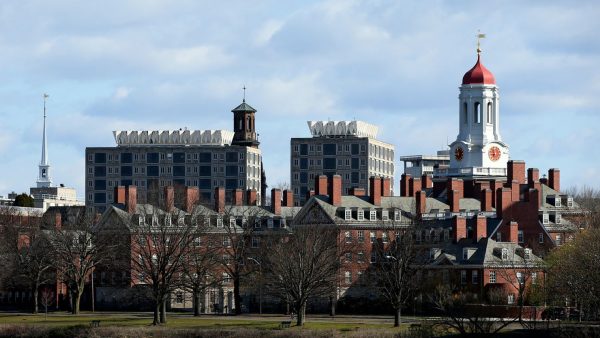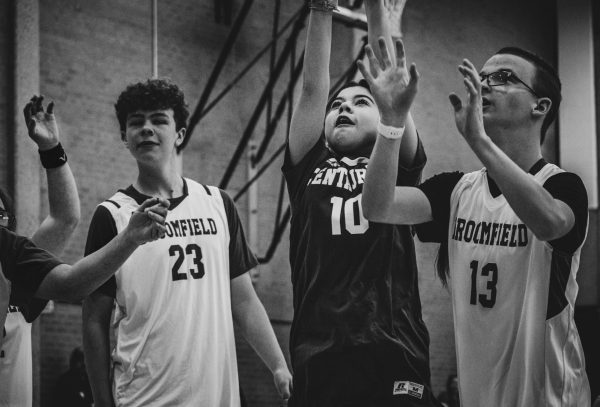Is it Time to Unmask?
BVSD indoor mask mandate has ended, effective 2/18. What does that mean for students and staff, and is it too soon?
A sign dictating the guidelines of the mandate that was ripped apart.
“I don’t know what people expect my chin to look like, so I will be keeping it on” states Carly Flannigan (sophomore). All across the school, the buzz has been spreading: masks are coming off.
On Monday, February 14th, the Boulder County Board of Health voted unanimously to rescind the public health order that requires masking indoors (the BVSD order requiring all students and staff K-12 to wear facial coverings in schools and during after-school activities was based on and followed this broader county order).. A statement on the official BVSD website reads: “BVSD is following federal, state and/or local orders on masking. As of February 18, 2022, Boulder County has ended its indoor mask mandate. Federal orders continue to require masking on buses.” Note: BVSD has since stopped requiring masks on buses, in accordance with new CDC guidelines. A similar statement was released via Twitter. Replies were filled with mixed feelings from parents: some glowing responses, some inflammatory. Feelings in the school building echoed those on Twitter. In contrast to BVSD, CU Boulder has stated that it will continue to require masking indoors.
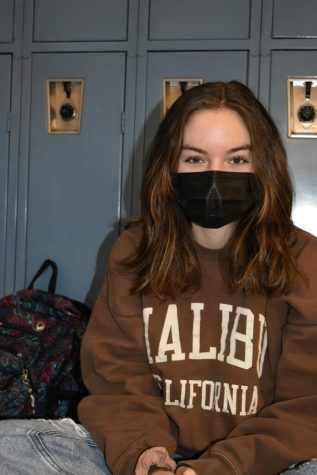
(Shira Nathan)
This decision comes 6 weeks after the peak of the Omicron variant in Colorado. According to Fox 31, “the state seven-day average for cases peaked around Jan. 10th”. In the last two weeks (early February), hospitalizations have decreased by 43%, and deaths by 38%. But Colorado, and Boulder County, still remain at high transmission levels, with cases at 43% of last winter’s U.S peak. Throughout the Omicron wave, little new regulations came from BVSD to keep up with the increased risk that the new variant posed to students and staff. Classes emptied as student after student tested positive. The school district changed the exposure policy, no longer emailing to inform of exposures, because everyone would receive several emails a day. There was talk of moving online, not due to the virus, but rather because of staffing shortages. But even after the peak there was no speculation of removing masks; it was assumed the mandate would remain until the end of the school year.
So what has changed? All around the country, as Omicron has slowed, states and districts such as in Indiana and Maryland have been choosing to remove masks in schools, while others such as Chicago and New York City have chosen to keep them in place until further notice. A lot has to be considered by the district in the decision: vaccination rates, risk factors, exposure and transmission levels, the list goes on. Erin Bromage, biology professor at the University of Massachusetts, told CNN that their opinion has changed on masking in schools, taking exactly those factors into consideration. “Children [and teens] are the least likely to have poor outcomes from infection, they have the opportunity to be vaccinated, and as long as the parent retains the right to have their [student] mask if they choose, then we should be moving to a situation where masks are optional. There are just too many negative tradeoffs in socialization and learning when [students] do not get to see faces and expressions.” Almost everyone at Centaurus is eligible for three shots of the vaccine, not to mention that teenagers are among the groups with the lowest risk from COVID. And masking is certainly still an option. This means that, by Bromage’s logic, the end of the mandate is right on schedule.
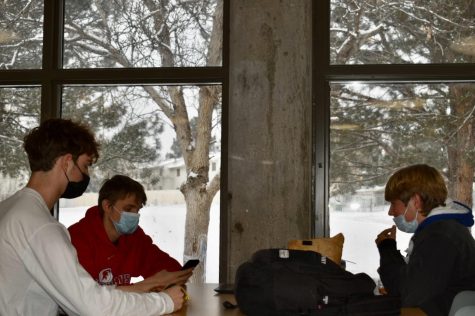
But more than COVID plays into this decision. The social emotional effect of masks has been huge. Students have worn masks in schools for almost two years. Many have never seen their classmates’ faces. Significant effects come along with that, whether they be positive or negative. Adolescence is a time ripe with insecurity for many teens, and masks have potentially served as a buffer. It leveled the playing field. Everyone wore one, and therefore everyone was relatively equal, similar to wearing a school uniform. On the other hand, many students have struggled with facial dysmorphia or other heightened conditions of dysphoria with their features due to masks. “We literally haven’t shown our faces to anyone while in school for more than a year, of course we’re going to be insecure. It feels like being naked because it basically is” stated Evy Ray (sophomore), after hearing that the mandate was ending. Xe has chosen to continue masking.
In addition to the appearance piece, judgment and assumptions have come with masking–assumptions about why people are or aren’t wearing a mask. Assumptions about their political beliefs or home situation. Now that it’s no longer required, there are new concerns about judgment: What will people think of my choice? What will they choose? Discussions of bullying and peer pressure have amped up as the mandate comes to an end.

(Shira Nathan)
Teachers want to be sure that students feel safe, no matter their choice. Ms. Deming, who teaches various forms of art, said to her 2nd period students “If anyone would like me to put a mask on when I come over to you, just let me know.” She has chosen to not continue to mask. “Looking at the stats… cases are heading down and I’m fully vaccinated. I’m trying to be very respectful, I don’t want people to see this [article] and think that I’m not…We’re going to live with this thing, and I don’t want to have to live with a mask on”.
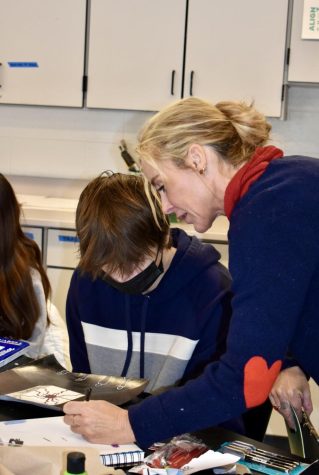
(Shira Nathan)
Classes and hallways have been split. Most students have continued masking off of their own volition, with various factors affecting the decision. But most teachers have chosen to stop. “Personally, I think I’m a better teacher without the mask…I had a headache every day because of how animated I am when I teach,” Ms. Senseney, who teaches APUSH, said of her decision. She had a graphic in her room addressing the topic.

(Shira Nathan)
The reality is, it’s a complicated issue. The mandates were in place because the science clearly stated it was necessary to protect students, staff, and families as much as possible. Now that the data has changed, the issue becomes more personal. The decision has a broad effect on students and their families. The district has now put it directly in the hands of the people affected. Ultimately, people will have to do what’s best for them. And even that can be hard to determine.
Ink Gibson (sophomore) is conflicted, like many others. “I don’t know if I’ll wear it… Human interaction is just so much better without a mask… So I guess I need to decide if it’s worth sacrificing safety for a better human experience.”
Your donation will support the student journalists of Centaurus High School. Your contribution will allow us to purchase equipment and cover our annual website hosting costs.
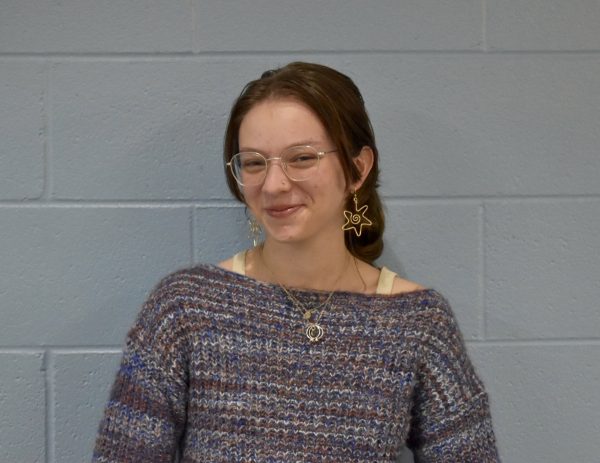
Shira Nathan (aka Ira) (they/them) is one of the Editors-in-Chief of The Warrior Scroll and a senior at Centaurus. This is their fourth year and final...




